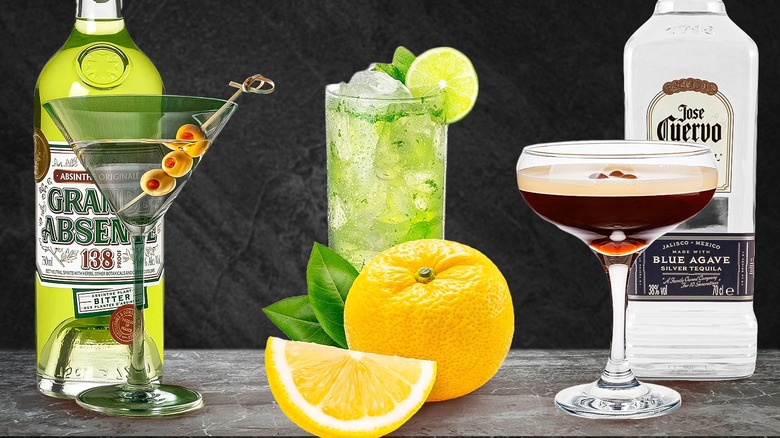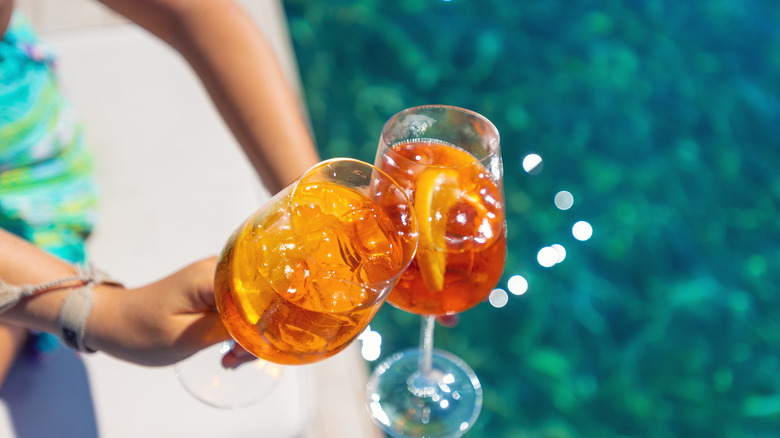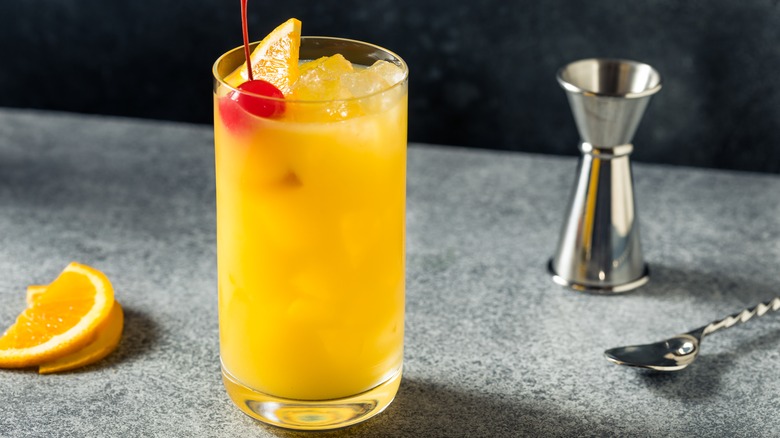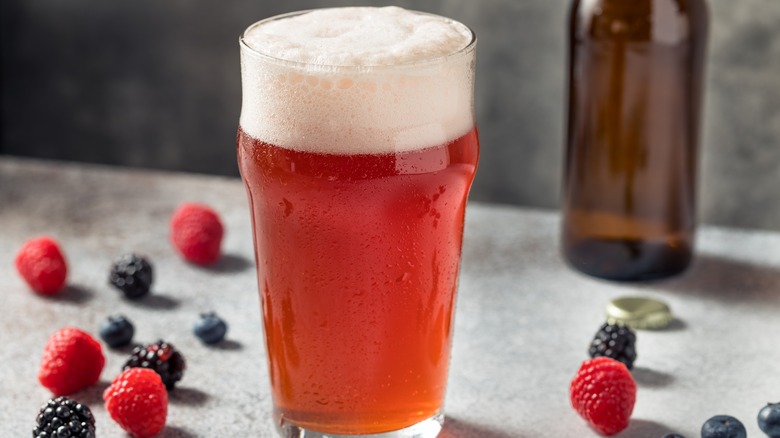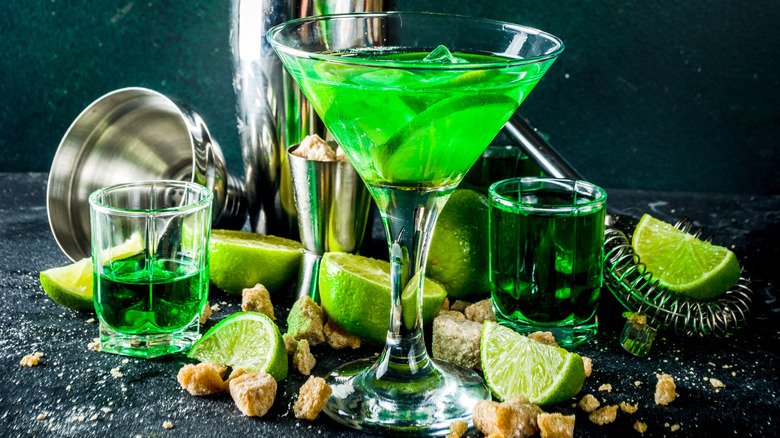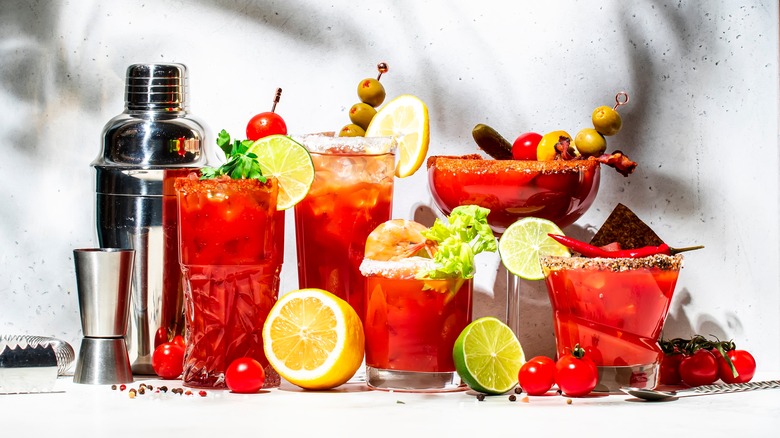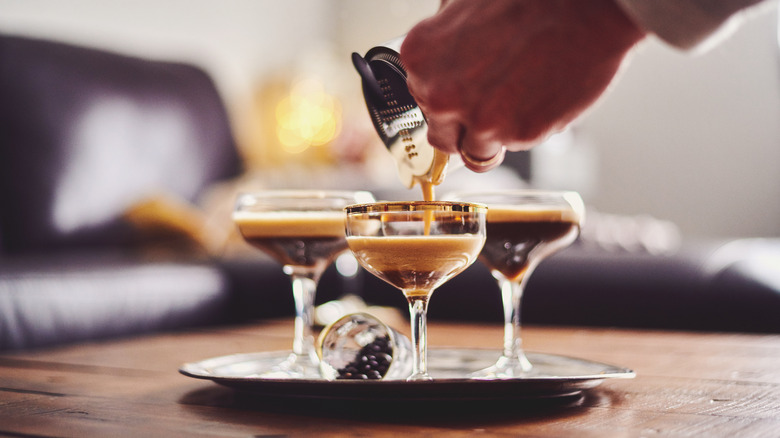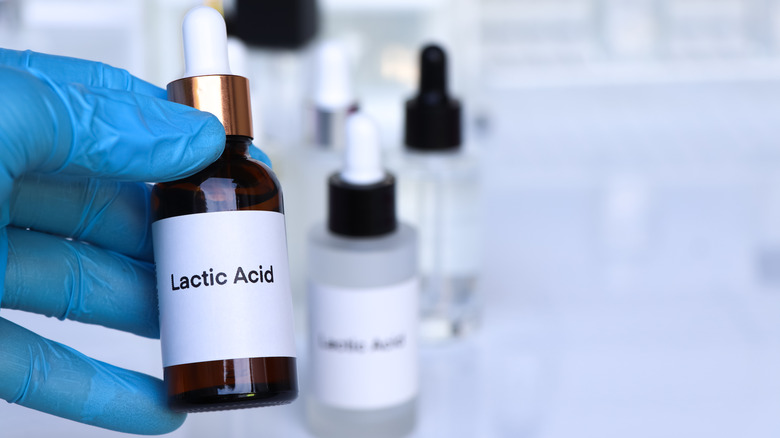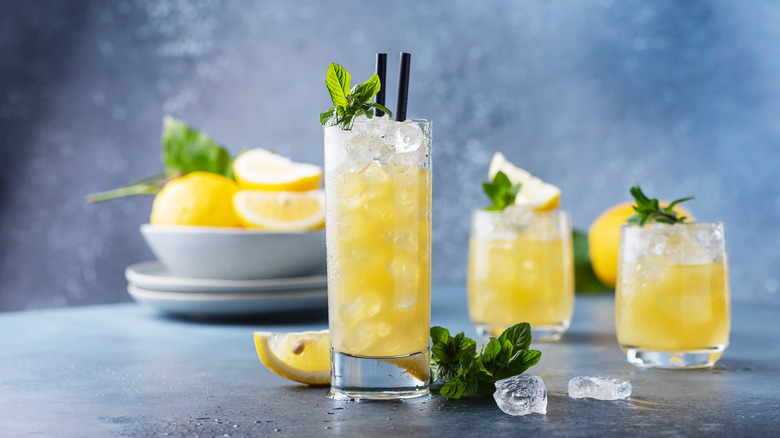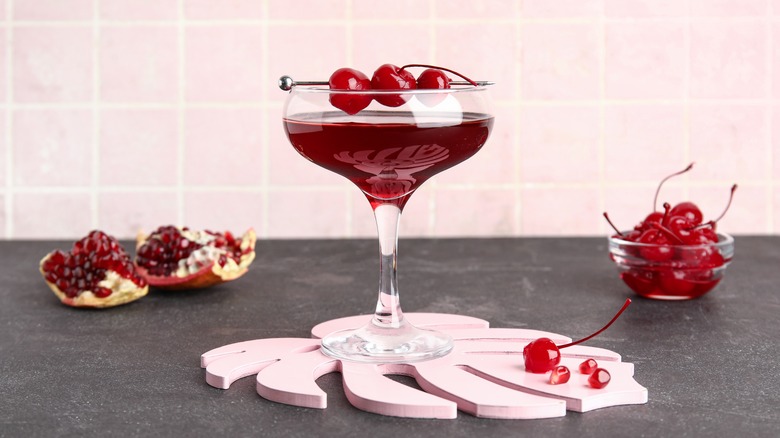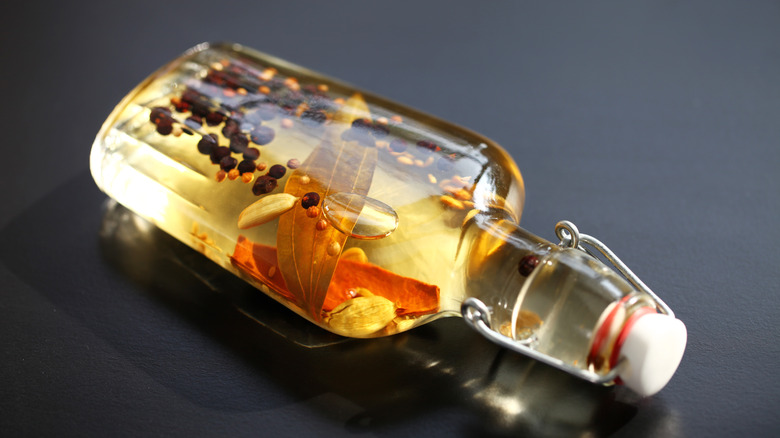A Bartender Shares Simple Ways To Make A Riff On 13 Popular Cocktails
Experimentation is at the very heart of bartending. Many "classic cocktails" we enjoy today were once riffs on existing cocktails (consider the martini, which originally comprised gin and sweet vermouth and, over time, it became more popular to make one with vodka and dry vermouth — or even olive juice), so it is in the spirit of drinking that it's worth trying new twists on tried-and-true recipes.
I have nearly a decade's worth of experience bartending across a variety of restaurants and bars, with additional experience as a private events bartender, so I'm well-equipped with the know-how for upgrading that classic cocktail. The following recipes are inspired by my own bartending experience, drink menus at bars I've visited, insight from colleagues, as well as previous intel provided by Tasting Table. Remember, like cooking, mixology is a combination of art and science — there are ingredients that are proven to go well together, but no recipe is ever set in stone. If you're a fan of any of the cocktails below, the next time you look over to your bar cart or liquor cabinet, consider one of these variations. Perhaps one of these riffs will even inspire you to create your own unique twist. Cheers!
Try out different apéritifs in your spritz
In recent years, the Aperol spritz has regained popularity — and we totally understand why. The combination of the sweet-bitter Aperol, bubbly prosecco, and soda water (with an orange to garnish) makes for a perfect choice on any warm, sunny day. To that point, look at any photo of streetside cafes in the U.S. or Italy; you're bound to see tables filled with spritzes.
But the Aperol Spritz is not the only option. By swapping out the Aperol (with its orangey-rhubarb flavor profile) and replacing it with another liqueur, you can create entirely new, complex flavors. The most common alternative to Aperol is Campari, which you can think of as Aperol's stronger and significantly more bitter counterpart. While it's still citrusy, it's more bitter and has much more punch (with an ABV around 25%, compared to 11% for Aperol).
That said, the riffs don't end there. Cynar, a herby amaro (after-dinner drink), is another option, as the liqueur's flavor profile is lightened with the introduction of prosecco and soda water. Meletti, another amaro, has a much sweeter flavor — caramel with spice — and is a great option for people who enjoy root beer. If these alternatives sound too cloy, consider St. Germain, limoncello, or Lillet Blanc — all of which have lighter, fruitier flavors. Whichever you choose, stick to the recipe of 3 ounces apéritif (or other liqueur), 3 ounces prosecco, and 1 ounce of soda water, served over ice.
Upgrade your screwdriver with unexpected ingredients
Technically a mixed drink, the screwdriver is a standard at any brunch. The combination of 1 part vodka to 4 parts orange juice is simple, but leaves plenty of room for new variations. Several cocktails already exist as riffs on the screwdriver, and we can all but guarantee you have not tried them yet.
First is the Harvey Wallbanger. It still has vodka and orange juice, but also has a floater of Galliano, a sweet herbal liqueur. It's a relatively simple recipe, but it takes some skill to pull off. To make the drink, add 1 ½ ounces of vodka and 4 ounces of orange juice in a glass with ice. Then, slowly pour ½ ounce of Galliano over the back of a (bar) spoon to get it to float on top of the drink. This liqueur adds a vanilla-anise kick to the drink. Second is the 007. No, this is not a martini (as 007 himself, James Bond, was apt to order); rather, the name comes from the ingredients of orange juice, orange vodka, and 7Up, giving the drink even more of a citrusy punch. Use one part each and serve over ice.
For something entirely different, swap out the vodka for blanc vermouth. Add 2 ounces of blanc vermouth (which falls somewhere between sweet and dry vermouth on the sweetness scale) and 1.5 ounces of orange juice over ice. Garnish with an orange peel, cherry, or even a sprig of rosemary
Add Chambord to that summer beer
Like the spritz, a shandy is a great summer cocktail. Adding a lemon-lime flavored beverage to a beer not only makes it more refreshing but hydrating, as well. There is already a wide variety of shandies (and radlers, the drink's close cousin), but typically, the drink comprises 50% beer and 50% lemonade, lemon soda, or other citrusy drinks. When making one, however, also consider the type of beer: wheat beers and light lagers (like a pilsner) are the best choices. A not-too-bitter IPA could also work, but you really don't want to get much heavier than that — it is summer, after all.
However, if you want to kick that shandy up a notch, ditch the lemonade and instead swap it for a fruit-forward liqueur, like Chambord. Adding 1 ounce of the raspberry liqueur will introduce a new fruit flavor to the drink without cutting the ABV in half. (In fact, at 16.5% ABV, Chambord will make the cocktail stronger than the standard beer.) Again, be considerate of the beer you opt for, and don't pick anything too fruity as it will contrast with the Chambord and could be too sweet.
Level up that martini with the green fairy
Now we're getting somewhere. As previously mentioned, the martini is a cocktail that's most often served differently today than when it was first invented around the turn of the 20th century. In fact, there are over a dozen variations of the martini that make use of different liquors, liqueurs, garnishes, and other ingredients.
One such alternate, the Obituary, uses the mysterious absinthe alongside the classic martini ingredients. To create the drink, this popular recipe calls for you to stir in a glass with ice 2 ounces of gin (preferably a London dry style), ¼ ounce of dry vermouth, and 1/12 ounce of absinthe, then strain into a chilled glass. If you're feeling a little more brave, add up to ¼ ounce of absinthe.
Some important information on absinthe: Unlike its reputation, absinthe is no more or less dangerous than other liquors. While it was once banned in numerous countries over fears of a hallucinogenic ingredient, those bans have been lifted, and that myth has been proven wrong. (That said, to be legal in the United States, absinthe cannot contain any thujone; this is the hallucinogenic ingredient, although typical absinthe does not have this in high enough quantities to cause them.)
Kick the bloody mary up a notch with a seasoned rim
The bloody mary — another brunch staple — can be made in any number of ways, and it can be garnished seemingly in even more ways. At its core, a bloody mary recipe comprises vodka, tomato juice, and a myriad of spices and seasonings. Common ingredients include Worcestershire sauce, lemon juice, hot sauces, celery salt, and black pepper. Garnishes typically include a celery stalk and sometimes olives. That said, new and menu-topping bloody marys might include shrimp or bacon as a garnish; others might utilize pickles, herbs, chicken tenders, and just about anything else you could come up with.
While the garnish may make the drink a bit more Instagrammable, it doesn't do much for the drink itself. To up the flavor profile of the standard bloody mary, be sure to give it a seasoned rim. Using Montreal steak seasoning can give your bloody mary a deepened savory flavor, perfect alongside that brunch entree. This seasoning blend includes black pepper, salt, dill seeds, onion powder, garlic powder, red pepper flakes, paprika, and coriander.
Spice up your whiskey sour with infused syrups
A great way to update the flavor profile of any cocktail is to infuse its ingredients with fruits, herbs, and the like. It takes a little extra preparation (and some patience), but it's definitely a worthwhile endeavor if your go-to cocktail has been seeming a bit stale as of late. One of our favorite riffs is spicy-smoky whiskey sour that incorporates a chipotle-infused simple syrup.
First, to create a proper whiskey sour (no pre-made mix included), add 2 ounces of (bourbon) whiskey, ¾ ounce lemon juice, ¾ ounce simple syrup, and ½ ounce egg whites to a cocktail shaker and shake. Do not add ice (yet). Give this a very solid shake (at least 10 seconds), then add in your ice and give it another good shake. The dry shake, as it's called, is what helps create that creamy, frothy texture emblematic of a perfect whiskey sour.
Now, we're going to go back in time — two days at minimum. In a small pot, add 1 cup water, 1 cup sugar, and a dried chipotle pepper. Bring to a boil and stir until the sugar is completely dissolved. Then, take the syrup off the heat, store it in an air-tight container, and chill. The longer this sits, the more the pepper flavor will infuse into the syrup; then use this in lieu of standard simple syrup on the recipe above.
Transform an espresso martini with tequila
The espresso martini is having a moment, as it's seemingly the de rigueur cocktail at bars across America, whether they have an espresso machine or not. The traditional ingredients are vodka, coffee liqueur, espresso, and simple syrup, but you will find bars that make the cocktail sans espresso and instead lean heavily on the coffee liqueur. In this instance, however, we are following the proper recipe — for the most part.
Instead of vodka (which is used because of its neutral flavor profile, allowing the coffee to shine), we are going to use reposado tequila. Using this instead of the vodka enhances the cocktail's flavor, and its nutty, toffee, and vanilla notes complement the espresso. This swap is guaranteed to make your espresso martini richer and more complex. And when it comes to the recipe, follow whichever espresso martini cocktail you prefer with the one substitution. We suggest 1 ounce reposado tequila, 1 ounce coffee liqueur, 1 ounce freshly brewed espresso, ½ ounce simple syrup, shaken with ice and strained into a chilled glass. Garnish with coffee beans.
Ditch the olive juice from that dirty martini
As already noted, there are countless ways to make a martini, and just about everyone has a preferred way to make theirs. We've already touched on one suggestion for upgrading the martini, but for those who remain wary of absinthe (or, perhaps, you just aren't a fan of the flavor), there are still plenty of alternative ingredients.
For those who favor the dirty martini, characterized by the savory, briny olive juice mixed in with the vodka or gin, we have plenty of new variations you can try. On the more familiar side, consider swapping in caper brine, chicken stock, green onion (which can be infused with alcohol), pickle juice, and even jalapeño brine. If you want to get a bit more creative, one such option is adding MSG (monosodium glutamate); mix the MSG with water (1 part to 50 parts, respectively) and use it in place of olive juice. To get even wilder, opt for lactic acid, which is gaining popularity at high-end cocktail bars. (Lactic acid is produced naturally as a result of fermentation and gives food a savory, tangy flavor.) You can purchase a solution online and mix 1 part lactic acid with 20 parts water.
Give the mojito this citrusy twist
We have to admit that the mojito, for as long as we can remember, has been one of our favorite cocktails. There's just something so refreshing about it. We also love that due to its relatively neutral ingredients, there are myriad ways to make new riffs on the drink. Just about any restaurant or bar that has a mojito on its menu very likely offers a handful of fruit-forward upgrades, including the likes of mango, strawberry, and watermelon. The "next big thing" in the world of mojitos, however, is yuzu.
The citrus hails from Asia, but its worldwide popularity has been gaining steam in recent years. Yuza has been cultivated in the United States for over 130 years, and even for citrus, it is particularly tart and seemingly blends the flavors of lemon, grapefruit, and orange. For this reason, we like yuzu with a mojito, playing off the sweetness of the rum and simple syrup. There are a couple of ways to make a yuzu mojito. In one way, you can muddle 3 mint leaves, yuzu, and ½ ounce simple syrup in a glass, then add ¾ ounce lime juice and 2 ounces white rum before shaking with ice. Pour into a glass and top with a bit of soda water. Alternatively, you can use yuzu-infused simple syrup and exclude the fresh yuzu from the muddling step.
Caramelize oranges for an upgraded old fashioned
Yet another of our go-to cocktails, we are always on the lookout for new riffs on the old fashioned. One we tried as soon as we discovered the concept is a caramelized orange old fashioned. It did not disappoint.
Already utilizing the orange flavor profile (as a proper old fashioned has the oils from an orange peel expressed onto the surface), the whiskey cocktail can only be upgraded when bringing more depth to the flavor of the orange. To make said caramelized oranges, make a caramel sauce (which can be a bit tricky to nail), saute the orange slices, and then combine in the pan. Consider adding orange juice into the caramel sauce to incorporate more of that flavor. Be sure to slice the oranges nice and thin so they don't overpower the cocktail when added.
As for the rest of the cocktail, like the martini, most have their preferred method for making the old fashioned; we like ours with rye whiskey (but bourbon is just as acceptable). Add 2 ounces whiskey and several dashes of Angostura bitters to a glass (optionally add ½ ounces simple syrup, but the caramelized oranges will provide plenty sweetness) and stir with ice. Strain over a glass with a large ice cube and garnish with the orange.
Swap out the OJ from your mimosa
Another mixed drink (technically) and brunch mainstay, the mimosa is just about as popular as any cocktail when it comes to daytime imbibing — and with good reason. That being said, there are plenty of ways to put a simple spin on the classic ingredients. The first option is swapping the orange juice for just about any other juice. We're particularly fond of pineapple or mango juice as a substitute (and feel free to opt for a fruit juice cocktail from the grocery store).
These swaps work nicely for any given day when you're considering a mimosa, but perhaps it's a holiday, and you want to make something a bit more themed. In the fall, try an apple cider mimosa (complete with a cinnamon-sugar rim — and even a splash of something heavier, like a brandy); for the winter holidays, use cranberry juice (and, again, for an added kick, include a splash of an orange liqueur like Grand Marnier) and garnish with cranberry and sprig of rosemary. A St. Patrick's Day staple is the green mimosa, simply made by swapping out the standard bubbles with a blue champagne.
Make a sweeter cosmopolitan with pomegranate juice
Although it's a bit uncertain when and where the cosmopolitan originated, it's no secret that it rose to fame in the 1990s. The light-pink cocktail is composed of vodka (historically lemon-flavored, but that's less common now), triple sec, lime cruise, and cranberry juice. For those who aren't a fan of that slightly bitter cranberry juice aftertaste, pomegranate juice offers a similar flavor profile but is slightly sweeter and certainly lacks that tang. One tip: Consider using unsweetened pomegranate juice, as the added sweetness from it, plus the other ingredients (namely, the triple sec), could make it a bit too sweet. This substitute will also give the drink a much deeper red color.
To make the pomegranate cosmo, add 2 ounces vodka, 1 ounce pomegranate juice, ½ ounce triple sec (such as Cointreau or Grand Marnier), and ½ ounce lime juice to a shaker with ice. Shake well and strain into a glass. Garnish with a lime (as the classic cosmo calls for), an orange slice (to pair well with the pomegranate), or even pomegranate seeds.
Infuse your vodka to upgrade simple vodka sodas
The vodka soda is about as basic as it gets when it comes to cocktails — and there's nothing inherently wrong with that. The good news is there are countless ways to take the drink up a notch, and all it takes is a little bit of time. Several days ahead of time (at least three to five), take your preferred (non-flavored) vodka and add it to a mason jar with, well, just about anything you want. Feel free to use fruits, peppers, cinnamon, vanilla beans, herbs, or whatever you like!
Use about a 2-to-3 ratio of fruit to vodka (say, 2 cups of blueberries to 3 cups of vodka). Let this sit for several days, giving the jar a good shake a couple of times a day. Keep an eye on the mixture, as it will tell you when it's ready to be strained. (Fruit, for instance, will slowly lose its color, and when it's nearly gone, you're all set.) Then, you will have a flavorful, homemade vodka ready to mix with club soda. Use a garnish that matches the flavor.
